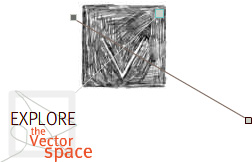Objects of Media Studies
Design by Raegan Kelly
Designer's Statement
Evocation, magic, liveness. Amelie Hastie used her object, the movie ticket stub, to describe her concept for Objects of Media Studies. She took me to the theater, esconced me in the dark, invited me to partake of the wonderful and fleeting pleasures particular to moviegoing--the light, the hush, the sense of wholeness, loss and discovery.
Our initial impetus was to inscribe the objects in the final collection, rendering them shot through with connection--to each other, to the personal, political, historical, social, economic, and cultural. Each object would be experienced as both screen and projection.
The seminar itself exploded that approach; over time, the group readings, conversations, thought and scrutiny engendered a conceptual space that for me was the object of the Objects of Media Studies project.
From within this collective conceptual space emerged themes of dust, screens, and exchange (specifically, the swap meet). Also guiding me: the tactile qualities of memory, desire and poignancy; re-animation; context; the prolonged collaboration between makers and viewers intrinsic to moving media.
+
The structure of Objects of Media Studies seeks to preserve author and object not as singularities but as the products of collective thought and action.
I turned to two texts wherein the act of reading is also an act of writing: Sven Lindqvist's A History of Bombing and Walter Benjamin's Arcades Project.
A diagram* I concocted of Lindqvist's book, a story of the 20th century in which 22 themes are broken into 399 sections and presented chronologically, is a diagram of the modes of reading afforded by Lindqvist's structural approach. You can read the book first page to last or you can follow the 22 themes, moving along a series of interlocking ellipses by reading forward then jumping back in the book to the next theme. The structure enacts the dovetailing of the personal and political described in his text. By puncturing the text's assumed linearity, a series of openings, accidents, and opportunities are presented the reader. (*not an exact representation of the sequencing of original text)

Visual depictions of Benjamin's Arcades resemble the space of the arcade, long punctuated galleries linked through theme, reference and sequence.
[The Collector]
[Dolls]:::[H1,1]
[H1,2] [H1a, 1]::::[Mirrors]
[H1,3] [H1a, 2]
[H1,4] [H1a, 3]
[H1,5] [H1a, 4]
[Diorama]::::::::::::[H1,6] [H1a, 5]
Benjamin's histories, accounts, sights, sounds, smells, references, and allegories recreate the space of the Arcades and its contents, a recollection screened through overlapping thematic filters.
In both Lindqvist and Benjamin the structure tends to collapse hierarchies between personal and 'official' history, and between citation and 'original' writing.
++
Wishing to acknowledge the aptness of the swap meet metaphor in the fabric of the design, I conceived of an interface that allowed the reader to 'wander' at will between the text segments and images of the eight object narratives using three columns of shifting content. Amelie, already implementing new structural approaches in her own writing, took on the immense task of piecing eight disparate voices into one coherent collective story with seven thematic access points. Together we devised a sequencing logic that interweaves the object narratives 'vertically' into her 'horizontal' collective narrative.
For the images we selected a set of cinematic tropes: zoom, fade, pan, tilt, dissolve, reveal. This second order access encourages exploration and interrupts reading rhythm by at times obliterating or dominating the interface.
+++
A promise of interactivity, to violate the author and promote the reader, seats you and me at the same table. And yet you are so very ephemeral, and I am left to wonder who you will be each time we encounter each other. And what to do when your spirit of patience and open inquiry meets with mismatched technologies? Step outside and sink your hands into the earth.



